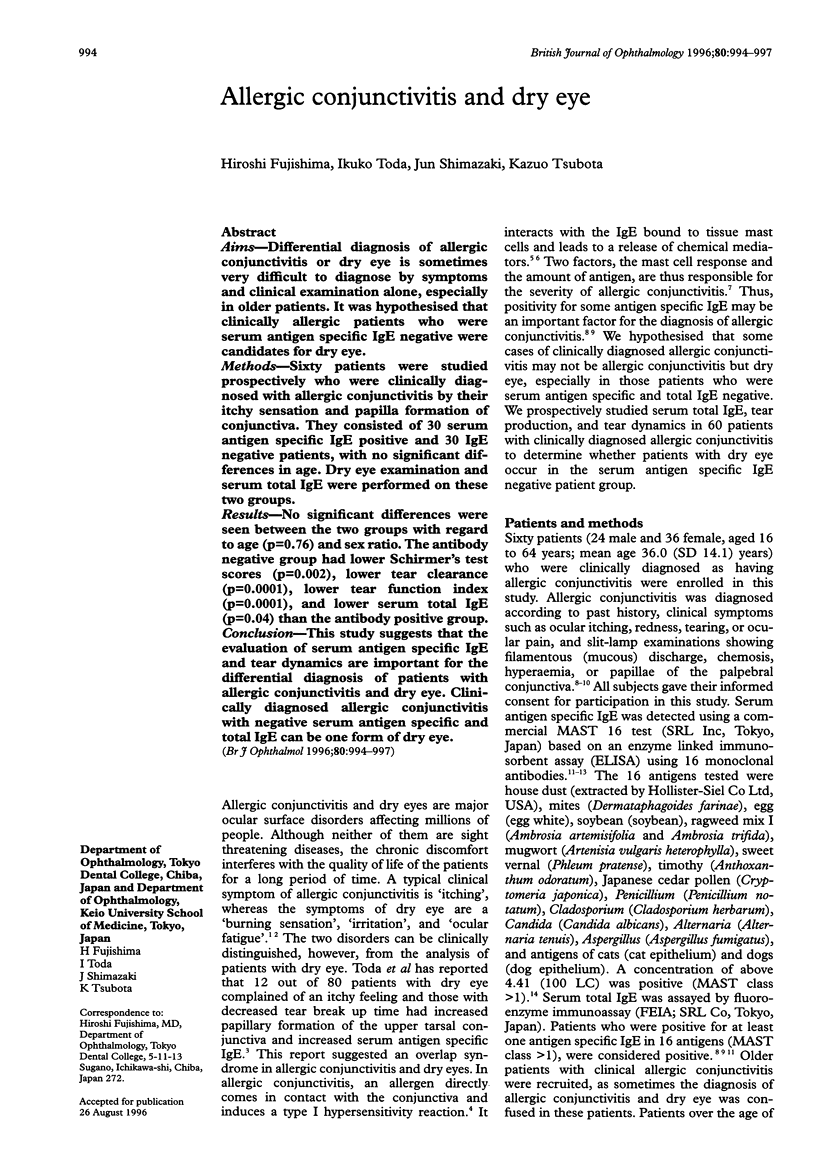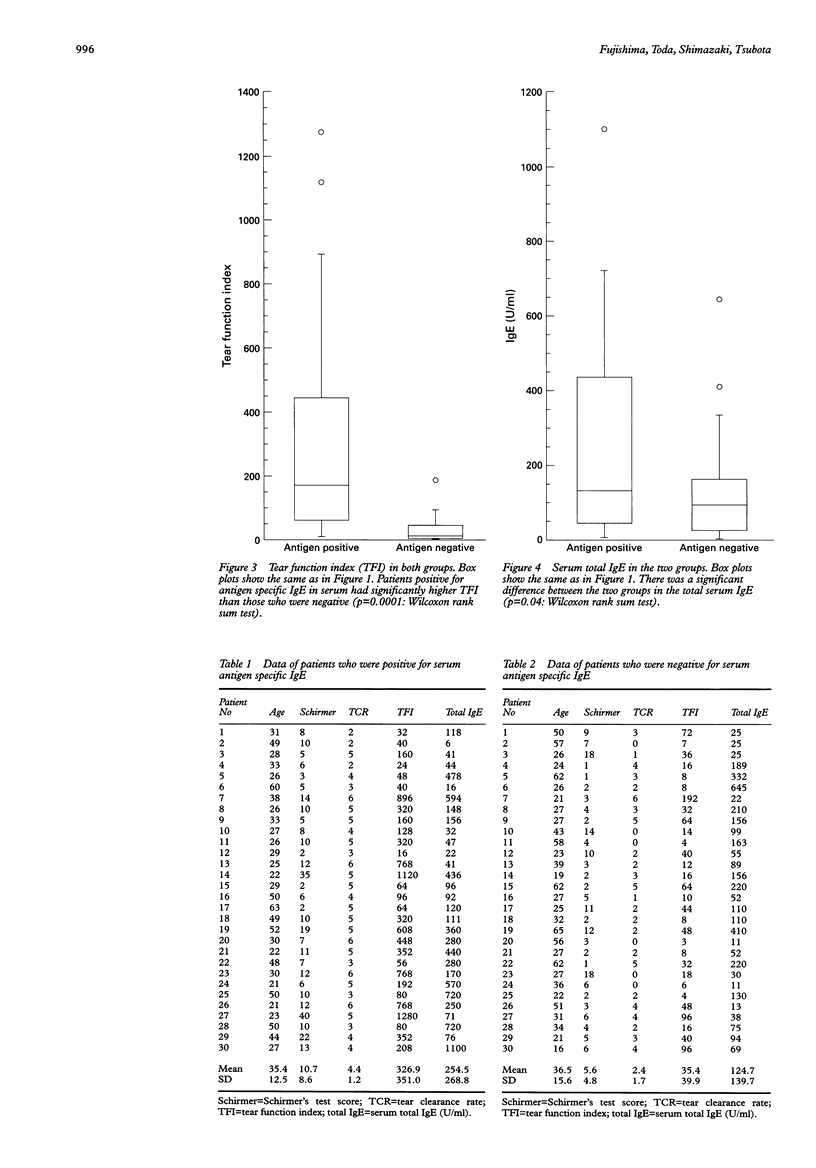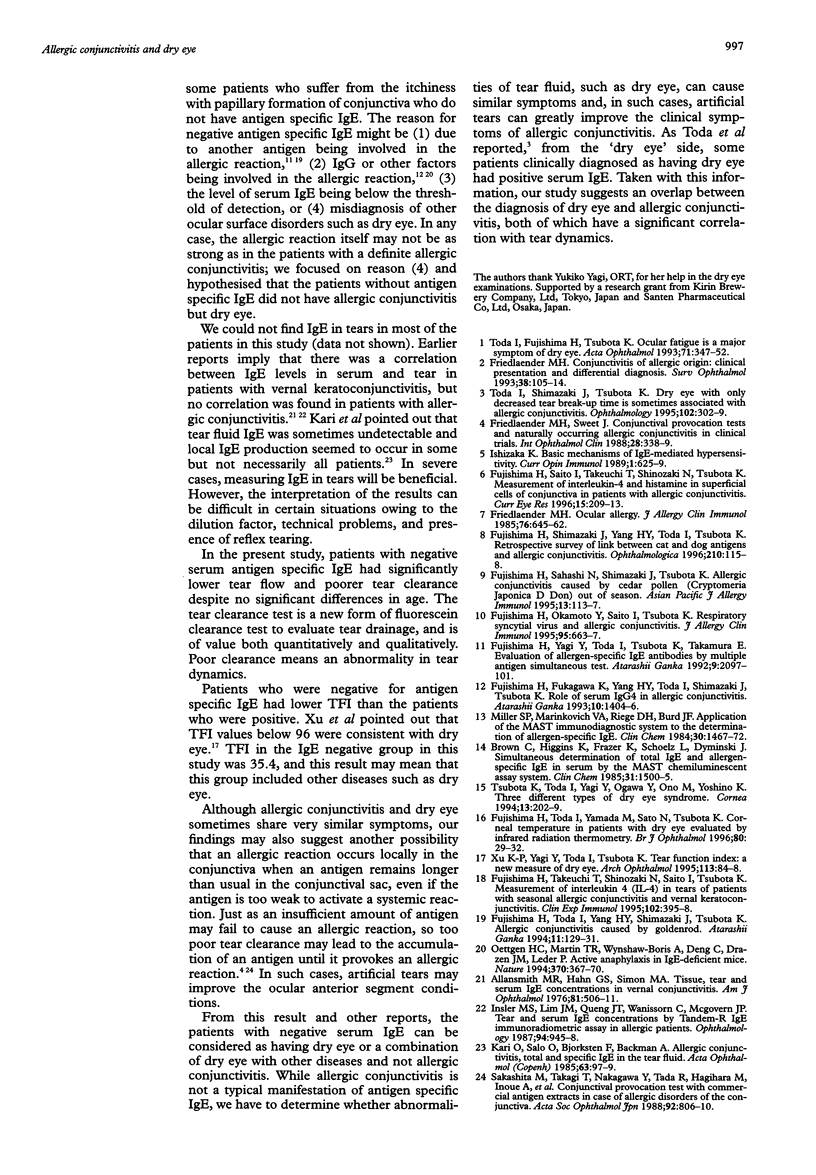Abstract
AIMS: Differential diagnosis of allergic conjunctivitis or dry eye is sometimes very difficult to diagnose by symptoms and clinical examination alone, especially in older patients. It was hypothesised that clinically allergic patients who were serum antigen specific IgE negative were candidates for dry eye. METHODS: Sixty patients were studied prospectively who were clinically diagnosed with allergic conjunctivitis by their itchy sensation and papilla formation of conjunctiva. They consisted of 30 serum antigen specific IgE positive and 30 IgE negative patients, with no significant differences in age. Dry eye examination and serum total IgE were performed on these two groups. RESULTS: No significant differences were seen between the two groups with regard to age (p = 0.76) and sex ratio. The antibody negative group had lower Schirmer's test scores (p = 0.002), lower tear clearance (p = 0.0001), lower tear function index (p = 0.0001), and lower serum total IgE (p = 0.04) than the antibody positive group. CONCLUSION: This study suggests that the evaluation of serum antigen specific IgE and tear dynamics are important for the differential diagnosis of patients with allergic conjunctivitis and dry eye. Clinically diagnosed allergic conjunctivitis with negative serum antigen specific and total IgE can be one form of dry eye.
Full text
PDF



Selected References
These references are in PubMed. This may not be the complete list of references from this article.
- Allansmith M. R., Hahn G. S., Simon M. A. Tissue, tear, and serum IgE concentrations in vernal conjunctivitis. Am J Ophthalmol. 1976 Apr;81(4):506–511. doi: 10.1016/0002-9394(76)90310-x. [DOI] [PubMed] [Google Scholar]
- Brown C. R., Higgins K. W., Frazer K., Schoelz L. K., Dyminski J. W., Marinkovich V. A., Miller S. P., Burd J. F. Simultaneous determination of total IgE and allergen-specific IgE in serum by the MAST chemiluminescent assay system. Clin Chem. 1985 Sep;31(9):1500–1505. [PubMed] [Google Scholar]
- Friedlaender M. H. Conjunctivitis of allergic origin: clinical presentation and differential diagnosis. Surv Ophthalmol. 1993 Jul-Aug;38 (Suppl):105–114. doi: 10.1016/0039-6257(93)90035-6. [DOI] [PubMed] [Google Scholar]
- Friedlaender M. H. Ocular allergy. J Allergy Clin Immunol. 1985 Nov;76(5):645–657. doi: 10.1016/0091-6749(85)90664-5. [DOI] [PubMed] [Google Scholar]
- Friedlaender M. H., Sweet J. Conjunctival provocation tests and naturally occurring allergic conjunctivitis in clinical trials. Int Ophthalmol Clin. 1988 Winter;28(4):338–339. doi: 10.1097/00004397-198802840-00018. [DOI] [PubMed] [Google Scholar]
- Fujishima H., Okamoto Y., Saito I., Tsubota K. Respiratory syncytial virus and allergic conjunctivitis. J Allergy Clin Immunol. 1995 Mar;95(3):663–667. doi: 10.1016/s0091-6749(95)70169-9. [DOI] [PubMed] [Google Scholar]
- Fujishima H., Sahashi N., Shimazaki J., Tsubota K. Allergic conjunctivitis caused by sugi (Cryptomeria japonica D. Don) pollen out of season. Asian Pac J Allergy Immunol. 1995 Dec;13(2):113–117. [PubMed] [Google Scholar]
- Fujishima H., Saito I., Takeuchi T., Shinozaki N., Tsubota K. Measurement of interleukin-4 and histamine in superficial cells of conjunctiva in patients with allergic conjunctivitis. Curr Eye Res. 1996 Feb;15(2):209–213. doi: 10.3109/02713689608997415. [DOI] [PubMed] [Google Scholar]
- Fujishima H., Shimazaki J., Yang H. Y., Toda I., Tsubota K. Retrospective survey of a link between cat and dog antigens and allergic conjuctivitis. Ophthalmologica. 1996;210(2):115–118. doi: 10.1159/000310686. [DOI] [PubMed] [Google Scholar]
- Fujishima H., Takeuchi T., Shinozaki N., Saito I., Tsubota K. Measurement of IL-4 in tears of patients with seasonal allergic conjunctivitis and vernal keratoconjunctivitis. Clin Exp Immunol. 1995 Nov;102(2):395–398. doi: 10.1111/j.1365-2249.1995.tb03796.x. [DOI] [PMC free article] [PubMed] [Google Scholar]
- Fujishima H., Toda I., Yamada M., Sato N., Tsubota K. Corneal temperature in patients with dry eye evaluated by infrared radiation thermometry. Br J Ophthalmol. 1996 Jan;80(1):29–32. doi: 10.1136/bjo.80.1.29. [DOI] [PMC free article] [PubMed] [Google Scholar]
- Insler M. S., Lim J. M., Queng J. T., Wanissorn C., McGovern J. P. Tear and serum IgE concentrations by Tandem-R IgE immunoradiometric assay in allergic patients. Ophthalmology. 1987 Aug;94(8):945–948. doi: 10.1016/s0161-6420(87)33355-x. [DOI] [PubMed] [Google Scholar]
- Ishizaka K. Basic mechanisms of IgE-mediated hypersensitivity. Curr Opin Immunol. 1989 Apr;1(4):625–629. doi: 10.1016/0952-7915(89)90031-9. [DOI] [PubMed] [Google Scholar]
- Kari O., Salo O. P., Björkstén F., Backman A. Allergic conjunctivitis, total and specific IgE in the tear fluid. Acta Ophthalmol (Copenh) 1985 Feb;63(1):97–99. doi: 10.1111/j.1755-3768.1985.tb05224.x. [DOI] [PubMed] [Google Scholar]
- Miller S. P., Marinkovich V. A., Riege D. H., Sell W. J., Baker D. L., Eldredge N. T., Dyminski J. W., Hale R. G., Peisach J. M., Burd J. F. Application of the MAST Immunodiagnostic System to the determination of allergen-specific IgE. Clin Chem. 1984 Sep;30(9):1467–1472. [PubMed] [Google Scholar]
- Oettgen H. C., Martin T. R., Wynshaw-Boris A., Deng C., Drazen J. M., Leder P. Active anaphylaxis in IgE-deficient mice. Nature. 1994 Aug 4;370(6488):367–370. doi: 10.1038/370367a0. [DOI] [PubMed] [Google Scholar]
- Sakashita M., Takagi T., Nakagawa Y., Tada R., Hagihara M., Inoue A., Yuasa T. [Conjunctival provocation test with commercial antigen extracts in cases of allergic disorders of the conjunctiva]. Nippon Ganka Gakkai Zasshi. 1988 May;92(5):806–810. [PubMed] [Google Scholar]
- Toda I., Fujishima H., Tsubota K. Ocular fatigue is the major symptom of dry eye. Acta Ophthalmol (Copenh) 1993 Jun;71(3):347–352. doi: 10.1111/j.1755-3768.1993.tb07146.x. [DOI] [PubMed] [Google Scholar]
- Toda I., Shimazaki J., Tsubota K. Dry eye with only decreased tear break-up time is sometimes associated with allergic conjunctivitis. Ophthalmology. 1995 Feb;102(2):302–309. doi: 10.1016/s0161-6420(95)31024-x. [DOI] [PubMed] [Google Scholar]
- Tsubota K., Toda I., Yagi Y., Ogawa Y., Ono M., Yoshino K. Three different types of dry eye syndrome. Cornea. 1994 May;13(3):202–209. doi: 10.1097/00003226-199405000-00002. [DOI] [PubMed] [Google Scholar]
- Xu K. P., Yagi Y., Toda I., Tsubota K. Tear function index. A new measure of dry eye. Arch Ophthalmol. 1995 Jan;113(1):84–88. doi: 10.1001/archopht.1995.01100010086025. [DOI] [PubMed] [Google Scholar]


